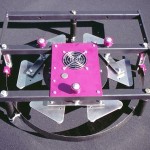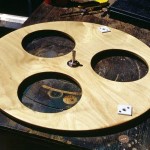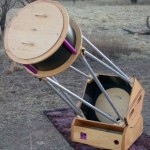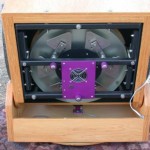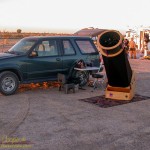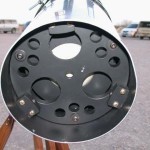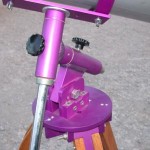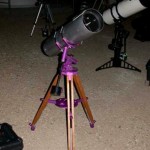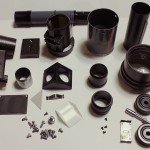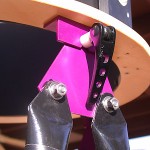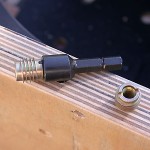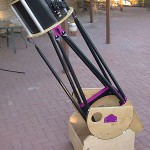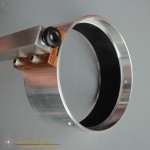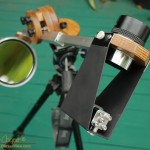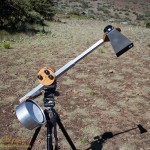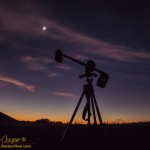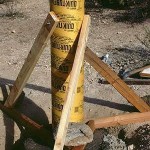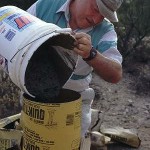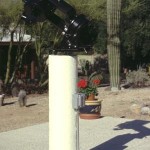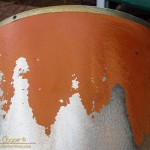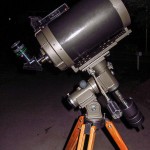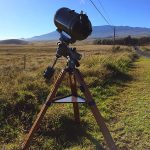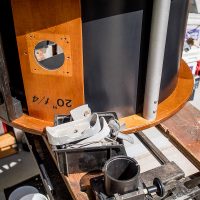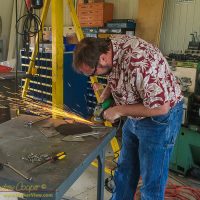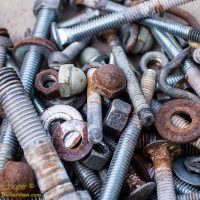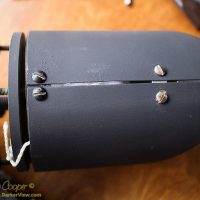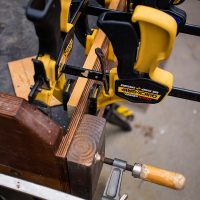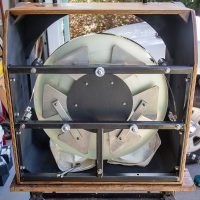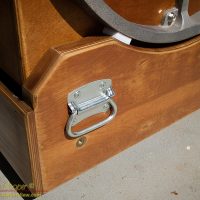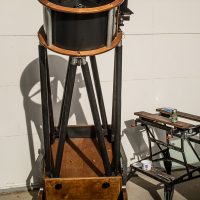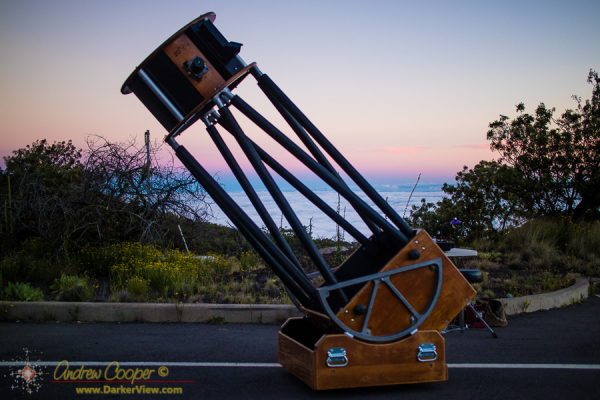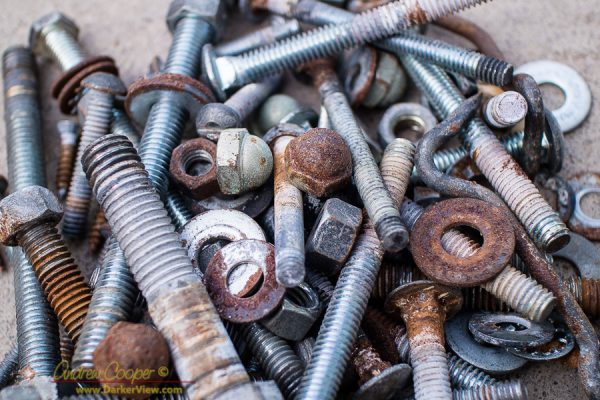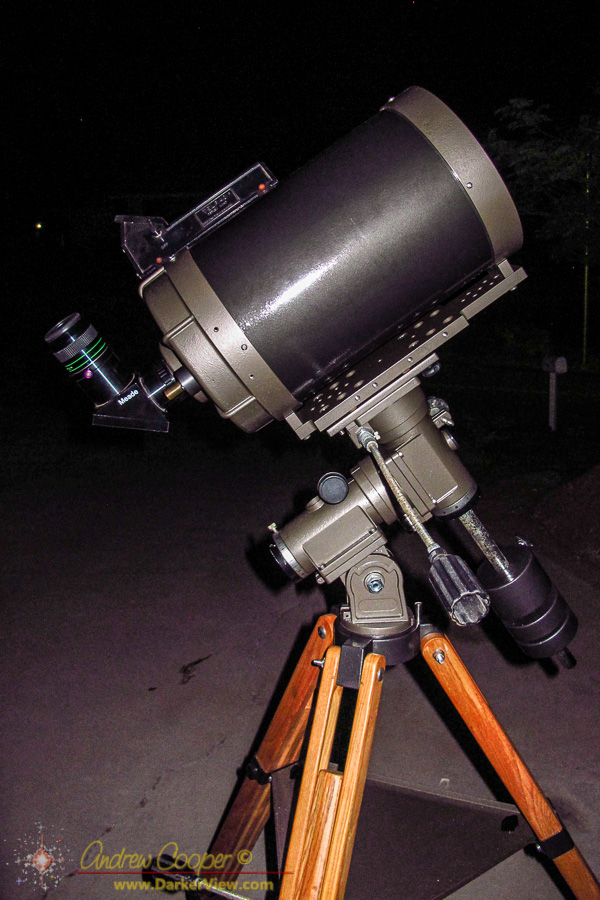Category: Telescope Making
The Dobsonian Telescope
In restoring a 20″ Obsession telescope I found myself pulling a book from the shelf that had not been opened in a while. David Kriege and Richard Berry’s The Dobsonian Telescope – A Practical manual for Building Large Aperture Telescopes is a book I once read cover to cover.
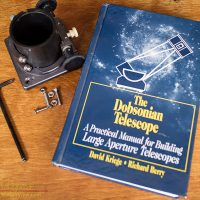
The Dobsonian Telescope is the primary reference for those building large amateur telescopes. This book, along with the design revolution that went with it, put large telescopes in the hands of countless amateur astronomers. These telescopes extended the capabilities of amateur observers immensely, allowing spectacular views of deep space objects that were only fuzzy smears in the eyepiece before. Want to see the spiral arms of galaxies? A 20″ telescope can do that!
As I perused my well thumbed copy I was surprised to find bits of my own telescope plans used as bookmarks. There was dust on the top of the pages, but I still remembered where I disagreed with Kriege in the dimensions of the mirror box, or how to place the truss tube clamps. I may have deviated from the plans shown here in some aspects, but in other parts of the design I directly used the dimensions shown in the book.
So many old memories, good memories. Pursuing an art that has been around for four centuries, combining bits of wood and glass to make an instrument that can reveal our universe. Sure you can simply buy a very good modern telescope. But it is hard to overstate the pleasure of building one yourself. This is an art that can still be done in a garage, with tools available at the local hardware store, with results that can rival or even surpass something purchased from a catalog.
Obsession in the Dusk
Restoring an Obsession
Obsession Telescopes are something of a standard in the astronomy community. David Kriege was one of the first to start building truss tube dobsonian telescopes commercially, bringing portable large aperture telescopes to the astronomy community. These telescopes were a bit of a revolution in the pursuit, with sizes unreachable only a decade before, when a 10″ or 12″ telescope was considered big. When I built my 18″ it is David Kriege’s book I used for much of the design, following in the footsteps of so many amateur astronomers.
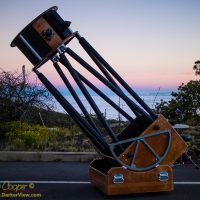
A 20″ f/4 Obsession donated to the observatory has presented a challenge and an opportunity. The telescope was the prized possession of Bob Michael having been ordered new directly from Obsession. The telescope is serial number 004 with a manufacturing date of June 1st, 1990. As David started Obsession Telescope in 1989, this is a very early example of his work. For many years Bob and his wife used this telescope to observe, completing the Herschel 400 and other observing projects. Unfortunately he was forced to give up astronomy due to age and glaucoma, donating his equipment to the observatory.
Clamps
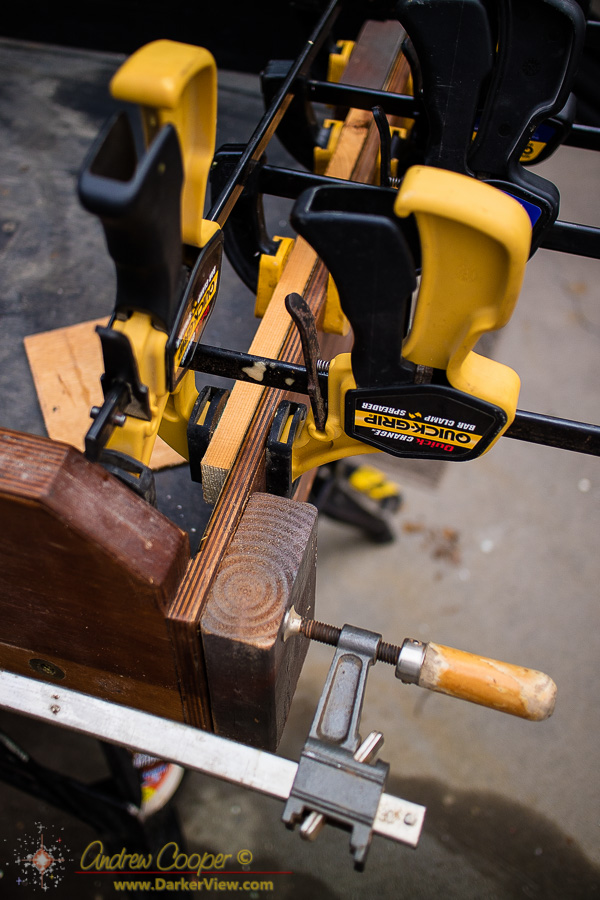
Rusted Hardware
Fungus on Glass
The tropical environment of Hawaiʻi is not kind to optical instruments. Tropical humidity can cause a host of issues ranging from corrosion of metal parts to decay of wooden and cardboard telescope structures. For those of us who build and use small telescopes the issues of tropical heat and humidity are rather concerning.
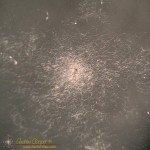
I have seen camera lenses lost to the white fungus. A friend once showed me a Canon 70-200 f/2.8 L, a $2000 lens, with fungus covering internal elements. Even on the “dry side” of Waimea the humidity was high enough to allow fungus to destroy this lens.
The problem is not an issue on the summit of Mauna Kea. The high altitude air typically exhibits a relative humidity of less than 10%. Several references note that a humidity of above 70% is needed to promote fungal growth on optics. We see no issues with fungal damage to the mirrors or instruments on the big ‘scopes.
Below the tropical inversion layer (about 6-7k feet) it is another issue entirely. Near sea level, where most of us live, humidity can remain above 80% much of the year. The warm and humid conditions of these islands are idea for growing anything, including the omnipresent fungal gardens that create the smells of a tropical landscape. Fungus is inescapable in this world, the spores drift on the wind and an stay dormant for decades, anywhere conditions are suitable fungus will grow.
The possibility of equipment damage was a major element in our buying a house. Waikoloa is located within one of the driest areas of the island. The humidity typically hovers in the 50’s, dry enough that I have had no issues with the multiple telescopes stored in the garage. Still, I do inspect stored equipment periodically, looking for the dreaded white fungus or other damage wrought by this tropical climate.
It is not a single species of fungus responsible for the problem. Apparently quite a few species are able to colonize an optical surface. Looking through the literature I find referenced to multiple species that can grow on optical glass…
The fungi which grow in optical instruments belong to the groups Phycomycetes, Ascomycetes and Fungi Imperfecti. The following species were frequently isolated from instruments which had been in New Guinea: Penicillium spinulosum, Thom.; P. commune, Thom.; P. citrinum, Thom.; Aspergillus niger, Van Tiegh.; Trichoderma viride, Pers. ex-Fr.; Mucor racemosus, Fres.; and M. ramannianus, A. Moeller. So far, Monilia crassa has not been isolated from Australian instruments, although Dr. W. G. Hutchinson (5) of the United States, found this to be a common species in the Panama zone, and it has also been recorded as frequent in West Africa by Major I. G. Campbell. – J.S. Turner, et al.1
I admit that the fungus can be pretty, in an odd sort of way considering the damage. Under a microscope it appears lacy, the mycelium fibrils growing across the glass in search of more nutrients to support the colony. In the center small round fruiting bodies are the launching point for new fungal spores.
I recently had another round of battle with fungus while restoring a collection of instruments that had been stored in a garage on the side of Hualalai. The high humidity had wrought impressive damage on both the optics and metal components of the telescopes. And there is fungus! Found in the eyepieces and on the telescope mirrors. During the cleaning and restoration of the instruments I found it necessary to completely dismantle many optical assemblies just to remove and kill the fungus. I some cases I was in time, but not completely, it is not without regret that I throw a $400 eyepiece into the trash.
Dealing with the fungus is imperative, cleaning and killing the growth before severe damage can be done may save the equipment. If the growth is severe enough the glass surface and the coatings can be damaged. Apparently the fungi can excrete hydrochloric acid, etching the surface and creating permanent damage.
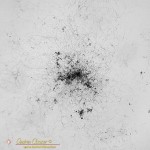
Killing the fungi requires a solvent that will both kill the fungus while not damaging the optical surface. I find references to both alcohol as well as other solvents. A mix of 50/50 hydrogen peroxide and ammonia is recommended by some references. Along with cleaning the glass I am careful to soak all of the structural elements as well. The tube, the spacers and lock-rings can all harbor minuscule colonies or spores awaiting suitable conditions to grow again.
Optical fungicide solutions tend to be expensive and hard to obtain, but they are available from some optical equipment manufacturers. Alternatively, you can use a 50/50 mix of hydrogen peroxide (H2O2) and ammonia (NH3). Usually, 5 ml of each is adequate (10 cc in total). Mix just prior to use and do not store the mixed product. – Ismael Cordero, Community Eye Health Journal2
Living in a warm humid environment one must be vigilant and ready to deal with issues when found. Examine optics regularly, keep a can of WD-40 next to the tool box (and use it), store optics and electronics with plenty of ventilation and reduce the humidity to well below 70% if needed. Extra vigilance to preserve valuable equipment is the price of living in paradise.
Refurbishing a TeleVue Renaissance Mount
I have already posted about the restoration of an orange tube C8. That was only part of the story, the telescope is paired with a TeleVue Renaissance mount that was in the same poor condition as the optical tube. The mount required the same treatment, a complete tear down and restoration to reverse the ravages that tropical humidity had wrought upon the metal parts.
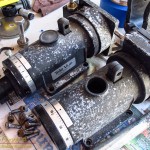
Corrosion was the issue. While the mount was mostly functional, it was looking horrible. The aluminum under the paint was corroding into a fine white powder. Most of the screws were quite rusted along with the counterweight shaft where the chrome was flaking away and the rust spreading. If allowed to continue the mount would soon be the piece of junk it looked like. There was something wrong with the clutches as well, they do not lock firmly and needed to be inspected.
The mount was sold by TeleVue in the 1980’s paired with their APO refractors. The mount is actually a re-labled unit manufactured by the Japanese firm Carton Optics as the model Super Nova or RSM2000. Well regarded by amateur astronomers you can find postings of well used and beloved mounts still in use thirty years later. Examining the mount I find I agree with those who like it. There is much to love in the solid smooth motion, this looks to be worth the effort of restoration.
Thus I set about the task of stripping down the mount into component pieces… Of the rusted hardware only one screw required drilling out, the hex drive head stripping when I tried to remove it. Fortunately I again had the proper tools, a set of easy outs to remove the remains of the screw after I had drilled the head off. I was able to remove the screw without any damage to the aluminum castings.
Almost finished…
Restoring an Orange Tube Celestron C8
It looked horrible! The paint was coming off everywhere with heavily corroded aluminum underneath. Most of the screw heads were small balls of rust, with hopefully enough remaining to fit a screwdriver to and remove. For a precision optical instrument this small telescope was not very encouraging.
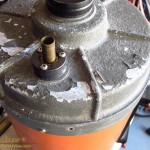
The telescope in question is an old orange tube Celestron C8. Thousands of these little telescopes were manufactured in the 70’s and 80’s. It was the C8 that set the standard for amateur telescopes at the time. The C8 is still in production forty years later, but the tubes are no longer painted orange as they were originally. Compact, yet offering decent performance, these telescopes were well regarded and hold a special place in the memories of many amateur astronomers. I have seen these little orange telescopes at dozens of star parties, even bolted to the side of huge professional telescopes for use as finders.


